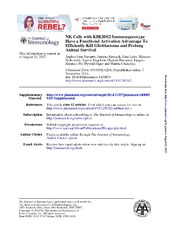NK cells with KIR2DS2 immunogenotype have a functional activation advantage to efficiently kill glioblastoma and prolong animal survival
Gras Navarro, Andrea; Kmiecik, Justyna; Leiss, Lina Wik; Zelkowski, Mateusz; Engelsen, Agnete; Bruserud, Øystein; Zimmer, Jacques; Enger, Per Øyvind; Chekenya, Martha
Peer reviewed, Journal article
Published version

Åpne
Permanent lenke
https://hdl.handle.net/1956/16716Utgivelsesdato
2014-12Metadata
Vis full innførselSamlinger
Originalversjon
https://doi.org/10.4049/jimmunol.1400859Sammendrag
Glioblastomas (GBMs) are lethal brain cancers that are resistant to current therapies. We investigated the cytotoxicity of human allogeneic NK cells against patient-derived GBM in vitro and in vivo, as well as mechanisms mediating their efficacy. We demonstrate that KIR2DS2 immunogenotype NK cells were more potent killers, notwithstanding the absence of inhibitory killer Ig–like receptor (KIR)-HLA ligand mismatch. FACS-sorted and enriched KIR2DS2+ NK cell subpopulations retained significantly high levels of CD69 and CD16 when in contact with GBM cells at a 1:1 ratio and highly expressed CD107a and secreted more soluble CD137 and granzyme A. In contrast, KIR2DS2− immunogenotype donor NK cells were less cytotoxic against GBM and K562, and, similar to FACS-sorted or gated KIR2DS2− NK cells, significantly diminished CD16, CD107a, granzyme A, and CD69 when in contact with GBM cells. Furthermore, NK cell–mediated GBM killing in vitro depended upon the expression of ligands for the activating receptor NKG2D and was partially abrogated by Ab blockade. Treatment of GBM xenografts in NOD/SCID mice with NK cells from a KIR2DS2+ donor lacking inhibitory KIR-HLA ligand mismatch significantly prolonged the median survival to 163 d compared with vehicle controls (log-rank test, p = 0.0001), in contrast to 117.5 d (log-rank test, p = 0.0005) for NK cells with several inhibitory KIR-HLA ligand mismatches but lacking KIR2DS2 genotype. Significantly more CD56+CD16+ NK cells from a KIR2DS2+ donor survived in nontumor-bearing brains 3 wk after infusion compared with KIR2DS2− NK cells, independent of their proliferative capacity. In conclusion, KIR2DS2 identifies potent alloreactive NK cells against GBM that are mediated by commensurate, but dominant, activating signals.